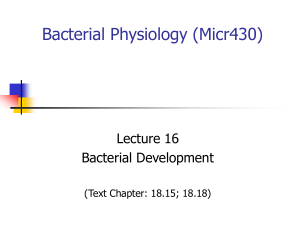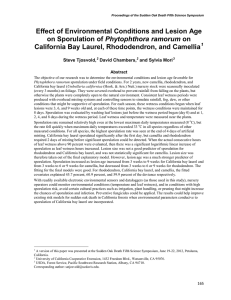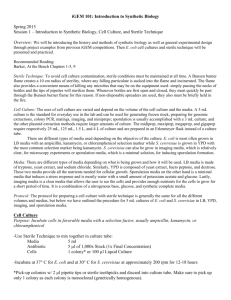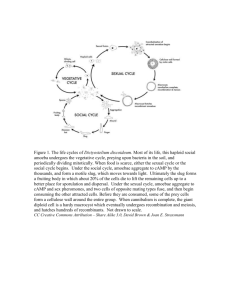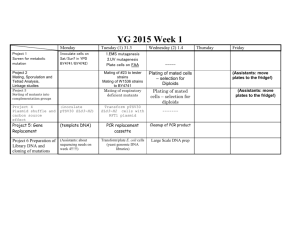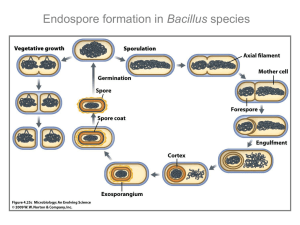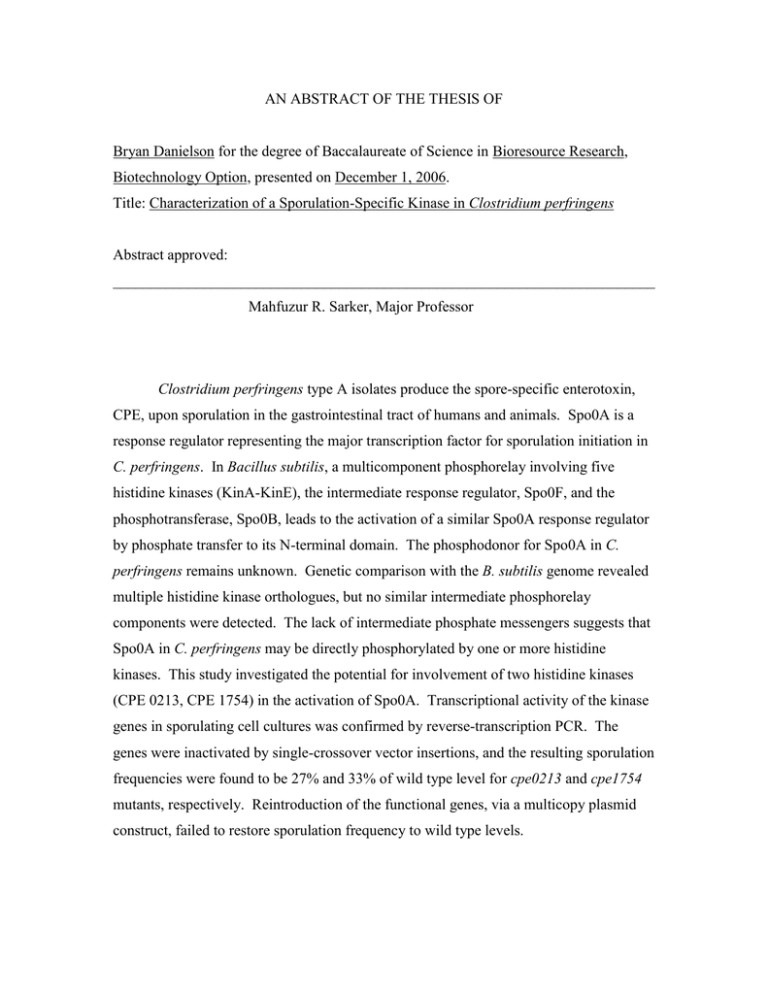
AN ABSTRACT OF THE THESIS OF
Bryan Danielson for the degree of Baccalaureate of Science in Bioresource Research,
Biotechnology Option, presented on December 1, 2006.
Title: Characterization of a Sporulation-Specific Kinase in Clostridium perfringens
Abstract approved:
________________________________________________________________________
Mahfuzur R. Sarker, Major Professor
Clostridium perfringens type A isolates produce the spore-specific enterotoxin,
CPE, upon sporulation in the gastrointestinal tract of humans and animals. Spo0A is a
response regulator representing the major transcription factor for sporulation initiation in
C. perfringens. In Bacillus subtilis, a multicomponent phosphorelay involving five
histidine kinases (KinA-KinE), the intermediate response regulator, Spo0F, and the
phosphotransferase, Spo0B, leads to the activation of a similar Spo0A response regulator
by phosphate transfer to its N-terminal domain. The phosphodonor for Spo0A in C.
perfringens remains unknown. Genetic comparison with the B. subtilis genome revealed
multiple histidine kinase orthologues, but no similar intermediate phosphorelay
components were detected. The lack of intermediate phosphate messengers suggests that
Spo0A in C. perfringens may be directly phosphorylated by one or more histidine
kinases. This study investigated the potential for involvement of two histidine kinases
(CPE 0213, CPE 1754) in the activation of Spo0A. Transcriptional activity of the kinase
genes in sporulating cell cultures was confirmed by reverse-transcription PCR. The
genes were inactivated by single-crossover vector insertions, and the resulting sporulation
frequencies were found to be 27% and 33% of wild type level for cpe0213 and cpe1754
mutants, respectively. Reintroduction of the functional genes, via a multicopy plasmid
construct, failed to restore sporulation frequency to wild type levels.
© Copyright by Bryan Danielson
December 1, 2006
All Rights Reserved
Characterization of a Sporulation-Specific Kinase in Clostridium perfringens
by
Bryan Danielson
A THESIS
submitted to
Oregon State University
Bioresource Research
in partial fulfillment of
the requirements for the
degree of
Baccalaureate of Science in Bioresource Research,
Biotechnology
Presented December 1, 2006
Commencement December 2006
Baccalaureate of Science in Bioresource Research, Biotechnology
Thesis of Bryan Danielson
Presented on December 1, 2006
APPROVED:
Mahfuzur Sarker, Mentor
Daniel Rockey, Committee Member
Katharine G. Field, Director of Bioresource Research
I understand that my project will become part of the permanent collection of Oregon
State University, Bioresource Research. My signature below authorizes release of my
project to any reader upon request.
Bryan Danielson, Author
ACKNOWLEDGEMENTS
This research was supported by a grant from Oregon State University’s (OSU)
Undergraduate Research Innovation Scholarship and Creativity program and by a grant
(to M. R. S.) from the USDA Food Safety Program (grant 2002-35201-12643). I am
sincerely grateful to Dr. M. R. Sarker and I-Hsiu Huang for mentoring me throughout the
project, to Nahid Mahfuz for her technical assistance, and to the rest of the people in the
laboratory for their support. I would like to thank Dr. K. G. Field for her critical editorial
comments and Dr. D.D. Rockey for sharing his laboratory resources with me and
providing helpful insight and suggestions pertaining to my project. I am also especially
appreciative of Wanda Crannell for devoting a tremendous amount of time and effort to
ensuring my successful completion of OSU’s Bioresource Research (BRR) program,
which is the undergraduate major that organized my research experience.
TABLE OF CONTENTS
Page
1. Introduction…………………………………………………...............
1
2. Materials and methods………………………………………..............
4
2.1 Bacterial strains and plasmids…………………………...............
2.2 Growth media…………………………………………................
2.3 Growth conditions……………………………………………….
2.4 Storage of bacterial stocks………………………………………
2.5 Transformations…………………………………………………
2.6 RNA isolation…………………………………………...............
2.7 Reverse transcription……………………………………………
2.8 Transcriptional activity………………………………………….
2.9 Construction and isolation of kinase mutants…………………...
2.10 Construction of kinase complementation vectors……………...
2.11 Sporulation assays……………………………………………...
2.12 Northern hybridization…………………………………………
4
5
5
6
6
6
7
7
7
8
9
9
3. Results………………………………………………………………...
11
3.1 Transcriptional activity………………………………………….
3.2 Construction of kinase mutants………………………………….
3.3 Sporulation assay for kinase mutants……………………………
3.4 Complementation of kinase mutants…………………………….
3.5 Sporulation assay for complementation…………………………
3.6 Northern hybridization…………………………………………..
11
12
14
15
16
18
4. Discussion…………………………………………………………….
19
5. References…………………………………………………………….
22
LIST OF FIGURES
Figure
Page
1. RT-PCR analysis of wild type C. perfringens strain SM101………....
12
2. Relevant characteristics of a generic inactivation vector for C.
perfringens genes cpe0213 and cpe1754………………………….......
13
3. Kinase gene inactivation by single-crossover vector integration…….
14
4. Relevant characteristics of a generic complementation vector for C.
perfringens genes cpe0213 and cpe1754……………………………...
16
5. Autoradiographic film exposure for Northern hybridization of spo0A
from 5-hour DS cultures ……………………………………………...
18
LIST OF TABLES
Table
Page
1. Strains and plasmids used in this study……………………………….
4
2. Repressed sporulation frequencies in kinase mutants………………...
15
3. Sporulation assay for complementation analysis……………………..
17
Characterization of a Sporulation-Specific Kinase in Clostridium perfringens
1. Introduction
Clostridium perfringens type A food poisoning is the third most reported bacterial
cause of food-borne gastrointestinal disease in the United States, and is widespread in
many other countries [10]. In the U.S., an estimated 250,000 cases occur each year,
resulting in an annual economic cost estimated to exceed $120 million [10].
C.
perfringens is a gram-positive, endospore-forming, anaerobic bacterium found naturally
in soil, water, wastewater, and the intestinal tract of most humans and other animals [3].
The incidence of heat resistant strains, which are typically implicated in food poisoning
outbreaks, range from 2% to 6% in the general population and between 20% and 30% in
hospital personnel and their families [10]. Isolates of C. perfringens produce a subset of
15 different toxins that have been identified to date [17]. Isolates are categorized into 5
types (A through E) based on production capability of four toxins: alpha, beta, epsilon,
and iota. C. perfringens type A is primarily implicated in foodborne gastrointestinal (GI)
illness due to production of Clostridium perfringens enterotoxin (CPE) [17]. Type C is
known to cause the lethal, food-borne necrotic enteritis; however the disease is very rare,
especially in the industrialized world [3].
CPE is a cytotoxic, heat labile protein producing major fluid accumulation and
histopathological damage on contact with intestinal epithelial tissue, as shown in rabbit
ileal loop experiments [3, 10,17]. The C-terminal binding domain targets one or more
cell receptor proteins, forming first a small, then a larger complex, ultimately resulting in
permeability changes of the host cell membrane and host cell death [3, 10]. Symptoms of
Type A food-poisoning are acute abdominal pain, diarrhea, and nausea lasting from 12 to
24 hours [1]. It is typically a self-limiting disease; however, fatalities may occur in
elderly, very young, or otherwise debilitated persons due to dehydration [3, 10].
C. perfringens type A food poisoning is a toxicoinfection resulting from CPE
production by sporulating type A isolates in the small intestine [3,17]. Spoilage by C.
perfringens occurs when foods are allowed to cool slowly after inadequate cooking [1],
especially when subsequently held at moderate temperatures for extended periods. The
endospores of food poisoning isolates, which are significantly heat resistant, survive
insufficient cooking, then germinate and propagate rapidly at moderate temperatures after
2
most or all competing flora have perished [1]. When food contaminated with large
numbers of vegetative C. perfringens is ingested, cells surviving gastric acidity multiply,
sporulate, and produce CPE in the small intestine [3]. The onset of symptoms occurs
from 8 to 12 hours post ingestion of at least 107 cells [3]. C. perfringens contamination
of food is facilitated by the organism’s ubiquitous nature, posing a frequent problem for
the food industry and establishments that prepare large quantities of food [1]. Although
the bacterium has been demonstrated to grow in a large number of foods, the highest
incidence occurs in meats or meat-containing products due to its dependency on external
sources for 13 different amino acids [1]. Meat dishes are most often the source of type A
food poisoning, possibly due to a slower cooling rate and higher incidence of foodpoisoning strains in meat [10].
One important and well-established phenomenon is the dependency of CPE
production on sporulation [7]. Large quantities of CPE are produced during the late
stages of sporulation, the peak of production being just before lysis of the cell’s
sporangium, whereupon the toxin is released [10]. In growth and sporulation media, CPE
may appear approximately three hours after inoculation with vegetative cells [10].
Although the mechanism for sporulation in C. perfringens remains unknown, knockout
mutant studies have identified a response regulator, termed Spo0A, essential for
sporulation and, therefore, CPE production in C. perfringens type A [9]. The response
regulator is a previously-identified orthologue of Spo0A in Bacillus subtilis, a sporeforming relative of C. perfringens [18]. In B. subtilis, Spo0A is a transcription factor
serving as the master regulator for entry into sporulation [13]. When a phosphate is
added to Spo0A’s N-terminal receiver domain, the protein is activated to induce or
repress over 500 genes [13, 15]. The mechanism for sporulation in B. subtilis has been
well characterized.
Activation of Spo0A is dependent on a multicomponent
phosphorylation-mediated pathway involving five sensor histidine kinases (KinA-KinE),
an intermediate response regulator, Spo0F, and the phosphotransferase, Spo0B [11]. In
this system, known
as the phosphorelay, an environmental signal induces
autophosphorylation of a sensor kinase, which subsequently phosphorylates Spo0F to
become Spo0F~P. Spo0B activates Spo0A by transferring to it, the phosphate from
Spo0F~P [4].
3
Since the components of the sporulation phosphorelay in B. subtilis are readily
identifiable as orthologues in related sporulation species [18], the previously
characterized mechanism for sporulation in B. subtilis represents a promising model upon
which to base applicable studies in C. perfringens.
Although the Spo0A response
regulator is present in the genome of C. perfringens, other obvious phosphorelay
components are not found [18]. This suggests that the intermediate response regulator
implicated in the multicomponent phosphorelay of B. subtilis is bypassed, where Spo0A
is directly activated by sensor kinases [18]. The central hypothesis for this study is that
one or more sensor histidine kinase(s) directly phosphorylate(s) Spo0A in the sporulation
pathway for C. perfringens. Genetic comparison to applicable kinases in B. subtilis
identified six sensor histidine kinases as potential participants in the sporulation pathway.
This study investigated whether two of the six candidate kinases, CPE 0213 and CPE
1754, are necessary for sporulation.
CPE is a major virulence factor for C. perfringens type A food poisoning [17].
As previously noted, large quantities of CPE are produced in sporulating cells.
Investigation into the mechanism for sporulation of type A isolates will generate
information regarding the molecular pathway to CPE production, thereby enhancing the
current understanding of the pathogenesis of type A food poisoning.
A greater
foundation of knowledge for the molecular basis of CPE production may facilitate the
discovery of inhibitory or therapeutic procedures or substances for this disease, making
this research important for the food industry and medical professions.
4
2. Materials and Methods
2.1 Bacterial strains and plasmids
C. perfringens strain SM101 was used because it is an enterotoxigenic type A
isolate. Strain SM101 and its derivatives, and the plasmids used in this study are listed in
Table 1.
Table 1. Strains and plasmids used in this study
Relevant characteristicsa
Source or reference
[14, 20]
SM101(Δ0213COMP)
SM101(Δ1754COMP)
Enterotoxigenic food-poisoning strain
carrying cpe on its chromosome, derivative
of NCTC 8798 selected for hightransformation efficiency
cpe0213 insertion/deletion mutant
derivative of SM101
cpe1754 insertion/deletion mutant
derivative of SM101
SM101(Δ0213) containing pJIR751(0213)
SM101(Δ1754) containing pJIR751(1754)
Plasmids
pCR®-XL-TOPO
PCR cloning vector; oriC; Kmr
Invitrogen™,
Carlsbad, CA
[2]
Strain or plasmid
C. perfringens
SM101
SM101(Δ0213)
SM101(Δ1754)
pJIR750
pJIR751
pMRS99
pTOPOXL(0213, catP)
pTOPOXL(0213, catP)
pJIR751(0213)
pJIR751(1754)
a
C. perfringens/Escherichia coli shuttle
vector; Cmr
C. perfringens/Escherichia coli shuttle
vector; Emr
pCR®-XL-TOPO® containing catP
Constructed by inserting an ~500 bp
internal cpe0213 PCR fragment into the
pCR®-XL-TOPO®, and the catP cassette
from pMRS99 into the EcoRV site; Cmr
Constructed by inserting a 400 bp internal
cpe0213 PCR fragment into pCR®-XLTOPO, and the catP cassette from pMRS99
into the EcoRV site; Cmr
An ~2.7 kb fragment containing cpe0213
and ~300 bps upstream of the ORF was
cloned into the KpnI/SalI sites of pJIR751
An ~2.0 kb fragment containing cpe01754
and ~300 bps upstream of the ORF was
cloned into the KpnI/SalI sites of pJIR751
Cmr, Emr indicate resistance to chloramphenicol and erythromycin, respectively
This study
This study
This study
This study
[2]
(M.R. Sarker)
This study
This study
This study
This study
5
2.2 Growth media
TGY broth (3% Trypticase, 2% glucose, 1% yeast extract, and 0.1% cysteine [5])
is a nutrient-rich medium used in this study when growth in the presence of antibiotics
was essential because its water-like consistency allows for adequate mixture of antibiotic
additives. Bacterial cells from TGY cultures were used for electroporations. Antibioticladen TGY broth was used to propagate colonies, selected from BHIA plates, following
electroporations.
Fluid thioglycolate (FTG) broth (Difco™, Sparks, MD) is a nutrient-rich medium
designed for anaerobic bacteria by forming a semi-gelatinous matrix and binding oxygen.
FTG broth was used to revive cultures that have been subjected to harsh conditions, such
as cooked meat and glycerol stocks, and was used when heat shocking spores.
Duncan-Strong (DS) broth is a nutrient-limited growth medium designed to
induce sporulation in C. perfringens [6]. DS media was used when spore production was
desired, such as in the preparation of cooked meat and glycerol stocks, selection for
sporulating isolates, and assays for sporulation frequency.
Cooked meat medium was used for long term storage of SM101 and sporulationcapable SM101 derivatives.
SM101 derivatives were grown and sporulated in DS
medium, then inoculated into cooked meat and incubated at 37oC for 24 to 48 hours.
Cooked meat cultures were frozen at -70oC for later use.
Brain-Heart Infusion agar (BHIA, Difco™) was used to grow C. perfringens
electroporated C. perfringens on plates.
2.3 Growth conditions
Broth media were heated by submersion in boiling water for 10 minutes and
cooled prior to inoculation to ensure anaerobic conditions. All broth cultures were
incubated without agitation at 37oC in a water bath.
Cooked meat cultures were
incubated without agitation at 37oC using a dry incubator. BHIA plates were incubated
in standard anaerobic jars using Becton Dickinson GasPak™ EZ Anaerobic Container
System (Difco™, Detroit, MI) at 37oC.
6
2.4 Storage of bacterial stocks
SM101 and sporulation-capable and SM101 derivatives were stored at -20oC in
cooked meat media for long-term stocks (see Growth Media and Conditions). All SM101
strains were stored at -80oC in 50% glycerol. Glycerol stock for Sporulation-capable
strains was prepared from cultures grown and sporulated in DS media, whereas stock for
non-sporulating strains was prepared from TGY cultures.
2.5 Transformations
All SM101 transformations were done by electroporation similar to the procedure
described in [5]. Briefly, overnight TGY cultures were centrifuged (20 minutes, 8,000
rpm) and washed twice with 6 mL of SMP buffer (270 mM sucrose, 1 mM MgCl2, and 7
mM NaPO4, pH 7.3 [5]), then resuspended in 1 mL SMP buffer. Approximately 5 µg of
vector DNA was added to 400 µL of cells. The cells were transferred to a 0.2cm BIORAD (Hercules, CA) Gene Pulser® cuvette and electroporated at a voltage of 2,500,
capacitance of 25 µF, and resistance of 200 Ω with the BIO-RAD Gene Pulser Xcell™.
Electroporated cells were immediately transferred to 3mL of TGY broth and incubated
for 3 hours at 37oC. Antibiotic selection was done on BHIA plates.
Chemically competent DH5α E. coli transformations were done by heat shock.
Vector DNA was added to 200 µL of competent DH5α glycerol stock (thawed on ice),
and incubated on ice for 30 minutes. The cells were transferred to a 5 mL Falcon® tube,
submerged in a 42oC water bath for 90 seconds, and placed on ice for two minutes. The
cells were inoculated into 1 mL of Tryptic Soy Broth (Difco), and incubated for 1 hour.
Cells were concentrated to 400 µL, distributed to four Tryptic Soy Agar plates with
appropriate antibiotics, and incubated at 37oC.
2.6 RNA isolation
Total RNA was isolated via the hot-phenol method as previously described [5,
20]. Briefly, cultures were centrifuged, separated from the supernatant, rigorously mixed
(pipetting) with 200 µL of Solution A (lysing solution; 20mM sodium acetate, 0.5 M
7
EDTA, 10% sodium dodecyl sulfate; sterile, deionized water), then rigorously mixed
with 200 µL of phenol. The mixture was shaken by hand for 5 minutes in a 60oC water
bath, centrifuged, and the supernatant layer (containing the RNA) was aspirated.
Absolute ethanol was gently mixed (2.5X) with the aspirant, and stored at -20oC for at
least 10 minutes.
The suspension was centrifuged, and the absolute ethanol was
aspirated. The RNA pellet was submerged in 500 µL of 70% ethanol, centrifuged for 1
minute, removed from the ethanol, and dissolved in RNase-free water. All centrifugation
steps were conducted at 14,000 rpm for 5 minutes unless otherwise specified.
2.7 Reverse transcription
Isolated mRNA was converted to cDNA using the Access RT-PCR System®
(Promega™, Madison, WI) according to the manufacturer’s directions. The reverse
transcription reaction was conducted by incubating samples with a thermocycler at 48oC
for 45 minutes.
2.8 Transcriptional activity
0.4 mL of Clostridium perfringens strain SM101 cooked meat culture was
inoculated into 10 mL of FTG broth and incubated overnight. 0.4 mL of the overnight
FTG culture was inoculated into DS broth and incubated for 5 hours. Cells from the 4hour DS culture were tested for cpe0213 and cpe1754 transcriptional activity. Briefly,
total RNA was isolated, and DNA contamination was eliminated by incubating RNA
samples with DNase at 37oC for 30 minutes.
Using the primers described below,
cpe0213 and cpe1754 mRNA was reverse-transcribed to cDNA and PCR-amplified. The
PCR reactions were electrophoresed on 1% agarose/TBE, stained with ethidium bromide,
and visualized with ultraviolet radiation.
2.9 Construction and isolation of kinase mutants
The cpe0213 inactivation vector was constructed as follows: A ~500 kb internal
fragment of cpe0213 was PCR-amplified using primers sequences, CPE0213RT-F (5’-
8
AAGATATAACCGAAGAATATACCC-3’)
AAGCTCAT-3’),
and CPE0213RT-R (5’-TATTAAGTGGTGTTCT-
and the fragment was cloned into pCR®-XL-TOPO® (Invitrogen™).
The catP cassette, excised from pMRS99 with EcoRV, was blunt-end ligated into the
EcoRV site of the vector construct to form pTOPOXL(0213, catP).
The cpe1754 inactivation vector was constructed as follows: A 400 kb internal
fragment of cpe1754 was PCR-amplified using primers sequences, CPE1754RT-F (5’AGTGGTTTAGGAAGCAGTGT-3’)
and CPE1754RT-R (5’-GCTTCTAAGCCATTTTGTTT -3’),
and the fragment was cloned into pCR®-XL-TOPO® (Invitrogen™). The catP cassette,
excised from pMRS99 with EcoRV, was blunt-end ligated into the EcoRV site of the
vector construct to form pTOPOXL(1754, catP).
pTOPOXL(0213, catP) and pTOPOXL(1754, catP) contain no origin of
replication for C. perfringens (oriCP), making them suicidal in the organism. The genes
were inactivated by single-crossover vector integration as described by Vagner and
colleagues [20].
2.10 Construction of kinase complementation vectors
The pJIR751(0213COMP) complementation vector was constructed as follows:
A ~2.7 kb fragment, containing cpe0213 and ~300 bp directly upstream from the open
reading frame, was amplified using primers, CPE0213COMP-F (5’-AAATAGTCAAAGTACAAAACTTC-3’)
and CPE0213COMP-R (5’-AGTGTTTTCTTAATGTACTTC3’), and ligated
into pCR®-XL-TOPO® (Invitrogen™).
The insert was excised from the resulting
construct with KpnI and XhoI and ligated into the KpnI and SalI sites of pJIR751 (M.R.
Sarker). The resulting vector was designated pJIR751(0213COMP).
The pJIR751(1754COMP) complementation vector was constructed as follows:
An ~2.0 kb fragment, containing cpe1754 and ~300 bp directly upstream from the open
reading frame, was amplified using primers sequences, CPE1754COMP-F (5’-ATTAAAGTAATAATAGGTCCTCAC-3’)
CTAG-3’,
and CPE1754COMP-R (5’-GGTGTTATAAAGTATTAATTAA-
and ligated into pCR®-XL-TOPO® (Invitrogen™). The insert was excised
from the resulting construct with KpnI and XhoI and ligated into the KpnI and SalI sites
of pJIR751 (M.R. Sarker). The resulting vector was designated pJIR751(1754COMP).
9
2.11 Sporulation assays
The sporulation assay for kinase mutants quantified sporulation frequency in wild
type SM101, SM101(Δ0213), and SM101(Δ1754), Table 2. The assay was conducted as
follows: 10 mL of FTG broth was inoculated with 0.4 mL of thawed cooked meat stock,
heated at 70oC for twenty minutes, and incubated overnight. 10 mL of DS broth with 5
µg/mL chloramphenicol (to retain mutant genotype) was inoculated with 0.4 mL of the
overnight FTG culture and incubated for 8 hours. 6 grid squares on a Helber Bacteria®
counting chamber (Weber Scientific International™, West Sussex, England) was used to
enumerate spores and vegetative cells. Sporulation frequency was calculated by dividing
the number of spores by the sum of spores and vegetative cells. Relative sporulation
frequency was calculated by dividing sporulation frequency by wild type sporulation
frequency. The relative sporulation frequencies reported in Table 2 were averaged over
three sporulation assay repetitions.
The
sporulation
SM101(Δ0213COMP),
assay
for
complementation
SM101(Δ1754COMP),
wild
analyzed
type
sporulation
SM101
in
containing
pJIR751(0213COMP), and wild type containing pJIR(1754COMP). Strains containing
either complementation vector exhibited severely diminished levels of sporulation. For
this reason, the second assay was designed to select for sporulating isolates with three
successive repetitions of 8-hour growth in DS; 70oC, 20-minute heat-shocking, and
overnight growth in FTG containing respective antibiotics. Spores and cell numbers
were estimated by visual inspection through a microscope due to obvious deficiencies in
sporulation frequency for strains containing the complementation vectors.
2.12 Northern hybridization
Northern hybridization was conducted according to the procedure described by
Philippe and colleagues [16]. Briefly, equivalent amounts (approximately 10 µL) of
RNA, isolated according to the procedure described above, were electrophoresed on 0.8%
agarose/TBE.
The gel was placed on 2 sheets of 20X SSC-soaked Whatman®
chromatography paper (Whatman International Ltd, Maidstone, England) in an aluminum
foil tray. Set atop, and fitted to the dimensions of the gel, the following items were
10
placed: a nylon membrane, 4 sheets of Whatman paper, and a three-inch stack of paper
towels, in respective order. The tray was filled with sufficient 20X SSC to cover the
bottom in a thin layer, approximately 0.25 Kg of weight was applied to the stack of paper
towels, and 12 to 16 hours was allowed for transfer. RNA was immobilized onto the
membrane by UV crosslinking, and incubated for 5 minutes at 55oC with
prehybridization buffer in a rotating oven. An alkaline phosphatase probe, synthesized
with the Amersham Biosciences Ltd (Buckinghamshire, England) AlkPhos Direct
Labelling Reagents kit, was added to the hybridization buffer and the membrane was
incubated for another 2 hours. The prehybridization buffer was discarded, primary wash
buffer was added, and the membrane was incubated for 10 minutes at 55oC in the rotating
oven. The buffer was exchanged with fresh primary wash buffer, and incubated for 10
minutes again. The membrane was transferred to a plastic container and washed twice
with secondary wash buffer for 5 minutes each on an orbital shaker at room temperature.
The membrane was dried and the hybridized RNA was reacted with CPD Detection
reagent for 5 minutes, enfolded with plastic wrap. The membrane was dried, enfolded
with fresh plastic wrap, and exposed to Amersham Biosciences Hyperfilm™
autoradiography film.
11
3. Results
Sensor histidine kinase genes, cpe0213 and cpe1754 were evaluated for
involvement in the sporulation pathway for C. perfringens. Transcriptional activity was
assessed during sporulation, and then cpe0213 and cpe1754 mutants were constructed to
evaluate sporulation in kinase-deficient mutants. Finally, the functional kinase genes
were introduced into the kinase mutants and sporulation was re-evaluated to verify that
the sporulation defects were caused by disruption of the target kinase genes.
3.1 Transcriptional activity
Reverse transcription (RT) PCR analysis for total RNA, isolated from sporulating,
5-hour DS C. perfringens strain SM101 cultures, amplified the 400 bp and ~500 bp
internal kinase fragments for cpe1754 and cpe0213, respectively (Figure 1, lane 3). A
positive control for the RT-PCR assay used chromosomal C. perfringens DNA to test
whether PCR was functioning. The positive controls for each gene produced bands
(Figure 1, lane 2) corresponding to the size of the RT-PCR test bands. A negative control
followed the procedure for the RT-PCR test reaction, but without adding reverse
transcriptase to test for chromosomal DNA contamination. The negative controls for
each gene produced no bands on the agarose gel, indicating that no DNA contamination
occurred in the assays (Figure 1, lane 4). These results indicate that cpe0213 and
cpe1754 are actively transcribed in the presence of a sporulation signal.
12
(A) cpe1754
1
(B) cpe0213
(+)
2
3
(-)
4
1
bp
(+)
2
3
(-)
4
bp
500
500
250
250
Figure 1. RT-PCR analysis of wild type C. perfringens strain SM101. RT-PCR reactions were
electrophoresed on 1% agarose, stained with ethidium bromide and visualized under ultraviolet radiation.
(A) Total RNA isolated from sporulating SM101 culture was reverse-transcribed and amplified via RTPCR with cpe1754-specific internal primers CPE1754RT-F and R. (B) Total RNA isolated from
sporulating SM101 culture was reverse-transcribed and amplified via RT-PCR with cpe0213-specific
primers CPE0213RT-R and F. Lane schemes for each gel are parallel and ladder band sizes are indicated
to the left. Lane 1 is a 1 kb DNA ladder. Lane 2 is a positive control that used chromosomal C.
perfringens DNA in the RT-PCR reaction. Lane 3 is the RT-PCR test reaction. Lane 4 is a negative
control that followed the RT-PCR test reaction, without the addition of reverse transcriptase.
3.2 Construction of kinase mutants
That C. perfringens actively transcribes both cpe1754 and cpe0213 when
subjected to sporulation conditions provided grounds for further investigation into
whether they play a role in sporulation.
cpe1754 and cpe0213 were inactivated to
evaluate the effect of a kinase-deficiency on sporulation capability in isogenic mutants.
The inactivation vectors were constructed from the PCR cloning vector, pCR®XL-TOPO® (Invitrogen).
They contain a chloramphenicol resistance cassette, an
internal kinase gene fragment, and no oriCP, making them suicidal in the organism
(Figure 2).
13
Inactivation vector
2. Cm
1.
Isolated chromosomal DNA
Kinase ORF
Figure 2. Relevant characteristics of a generic inactivation vector for C. perfringens genes cpe0213 and
cpe1754. (1.) Internal kinase gene fragments (400 bp and ~500 bp for cpe1754 and cpe0123, respectively)
were PCR-amplified from chromosomal DNA and ligated into the PCR cloning site of pCR®-XL-TOPO®.
(2.) The catP chloramphenicol resistance cassette (~750 bp) was ligated into the EcoRV site of the
construct. The inactivation vectors are suicidal in C. perfringens as they contain no oriCP.
Kinase genes cpe0213 and cpe1754 were inactivated in separate C. perfringens
strain SM101 isolates.
The inactivation vectors were used to transform SM101 to
chloramphenicol resistance by electroporation. Kinase genes were inactivated on the
chromosome when the vector integrated into the kinase ORF on the chromosome via a
single-crossover event (Figure 3).
Mutants were selected for by distributing the
electroporated cells on BHIA containing chloramphenicol. Chloramphenicol-resistant
colonies were obtained after approximately three transformation attempts for SM101 with
inactivation vectors, TOPOXL(0213, catP) and TOPOXL(1754, catP).
The colonies
were inoculated into TGY broth with chloramphenicol (20 µg/mL), incubated overnight,
and those that formed cultures were designated mutants SM101(Δ0213) and
SM101(Δ1754), accordingly.
14
E.
Inactivation
Vector
D. Cm
B.
A.
C.
B.
F.
Kinase ORF
Chromosome
a.
b.
c.
d.
e.
b.
f.
Figure 3. Kinase gene inactivation by single-crossover vector integration. The inactivation vectors were
used to transform C. perfringens strain SM101 to chloramphenicol resistance by electroporation. The
internal kinase fragments align with their corresponding sequence on the chromosome. Being suicidal in C.
perfringens, chloramphenicol resistance passes to the progeny only after crossover of the vector into the
chromosomal kinase gene, thereby inactivating it. Capital letters A. through F. sequentially trace the path
of the DNA polymerase upon crossover, where B. is the internal kinase fragment, which is replicated twice.
C. represents the catP chloramphenicol resistance cassette. Lowercase letters a. through f. correspond to A.
through F. to indicate the resulting sequence on the chromosome.
3.3 Sporulation assay for kinase mutants
After construction and isolation, the sporulation frequencies for the kinase
mutants were evaluated.
The strain to which mutant sporulation frequencies were
compared in the sporulation assay for kinase mutants was wild type SM101 transformed
with pJIR750 to chloramphenicol resistance (20 µL). This was done to negate the effects
of antibiotics on sporulation for wild type derivatives by using equivalent
chloramphenicol concentrations during sporulation in DS for all strains.
cpe0213 and cpe1754 were found to sporulate at 1/3 the frequency of SM101
based on three trials (Table 2). Reduction in sporulation frequencies for kinase mutants
were analyzed by a 2-sample t-test with 4 degrees of freedom, and are considered
significant for p<0.01. The significant reduction in sporulation for the kinase mutants
provides evidence that both cpe0213 and cpe1754 are involved in the sporulation
pathway for C. perfringens and also provides the need for further investigation.
15
Table 2. Repressed sporulation frequencies in kinase mutants
Strain
Relevant
genotype
Relative
sporulation
frequencya
SM101b
pJIR750
1.00
SM101(Δ0213)
Δcpe0213
0.27
SM101(Δ1754)
Δcpe1754
0.33
a
Relative sporulation frequency represents the ratio of spores to the sum of
cells and spores, standardized to wild type sporulation frequency and
enumerated by the method described in the Materials and Methods.
b
Wild type SM101 was transformed with pJIR750 (Cmr) to negate antibiotic
effects on sporulation.
3.4 Complementation of kinase mutants
The
functional
kinase
genes
were
introduced
into
the
mutants
on
complementation vectors, pJIR751(0213COMP) and pJIR751(1754COMP), which
constructed from the E. coli/C. perfringens shuttle vector, pJIR751 [2]. The vectors
include an erythromycin resistance cassette, an insert containing the kinase ORF and
~300 bp upstream to include the promoter region, and an oriCP (Figure 4).
16
3. oriCP
Complementation
vector
2. Em
1.
Isolated Chromosomal
DNA
Promoter
region
Kinase ORF
Figure 4. Relevant characteristics of a generic complementation vector for C. perfringens genes cpe0213
and cpe1754. (1) The kinase ORFs and ~300 bp upstream to include the promoter region (a total fragment
size of ~2.7 kb and 2.0 kb for cpe0213 and cpe1754, respectively) were ligated into the SalI and KpnI sites
on pJIR751. Each vector contains an erythromycin resistance cassette (2), and an oriCP (3).
Complemenation vectors, pJIR751(0213COMP) and pJIR751(1754COMP)
contain an origin of replication for C. perfringens, and may replicate multiple times
within the organism. pJIR751(0213COMP) and pJIR751(1754COMP) were used to
transform, by electroporation, SM101(Δ0213) and SM101(Δ1754), respectively, to
erythromycin resistance.
Putative transformants, which were selected for with
chloramphenicol (20 µL) and erythromycin (30 µL) on BHIA, were considered
transformants when growth occurred in TGY broth containing chloramphenicol (20 µL)
and erythromycin (30 µL). The transformants were designated SM101(Δ0213COMP)
and SM101(Δ1754COMP).
3.5 Sporulation assay for complementation
Sporulation was evaluated for SM101(Δ0213COMP) and SM101(Δ1754COMP)
according to the method described in the materials and methods. Transformation of the
complementation vectors into both kinase mutants did not complement the sporulation
deficiency, and may have reduced it further (Table 3). This may indicate that the
17
sporulation deficiencies observed in the kinase mutants may have been caused by some
consequence of genetic alteration other than disruption of the target kinase genes.
In order to determine whether the complementation technique will work for these
genes, pJIR751(0213COMP) and pJIR751(1754COMP) were each used to transform, by
electroporation, separate wild type SM101 isolates to erythromycin resistance, as a
control. The two putative transformants were selected with erythromycin (50 µL) on
BHIA, and were considered transformants when growth occurred in TGY broth
containing erythromycin (50 µL) and erythromycin (30 µL). These complemented wild
type strains were used to test the effects of the complementation vectors on sporulation in
wild type C. perfringens. Table 3 shows that the constructed complementation vectors
reduce sporulation in wild type SM101 to either mutant levels or less. These results
indicate that this complementation technique can not be used for these genes.
Table 3. Sporulation assay for complementation analysis
Strain
Relevant Genotype
Qualitative sporulation
assessmenta
SM101b
pJIR750
Similar to wild type
SM101(Δ0213COMP)
Δcpe0213,
pJIR751(0213COMP)
≤ cpe0213 kinase
mutant
SM101(Δ1754COMP)
Δcpe1754,
pJIR751(1754COMP)
≤ cpe1754 kinase
mutant
SM101(0213COMP)c
pJIR751(0213COMP)
No detectable
sporulation
SM101(1754COMP)c
pJIR751(1754COMP)
No detectable
sporulation or
≤ cpe1754 mutant
Complemented mutants
Complemented wild type
a
b
c
Sporulation frequencies for strains in the complementation assay were qualitatively assessed by
visual inspection of sporulating cultures with a microscope. Accurate numeric data could not be
obtained due to severe sporulation deficiencies in the strains containing the complementation
vectors.
The wild type SM101 strain that was transformed with pJIR750 (Cmr) to negate antibiotic effects on
sporulation in the sporulation assay for mutants (Table 2) was used.
Each complementation vector was introduced into wild type SM101 to test complementation vector
effects on sporulation for unaltered C. perfringens
18
3.6 Northern Hybridization
In an effort to understand why the complementation vectors did not complement
sporulation in the mutants, and decreased sporulation in wild type SM101, spo0A
transcriptional activity was quantified in the complemented wild type SM101 strains,
SM101(0213COMP) and SM101(1754COMP) via Northern hybridization. The strains
were propagated in DS medium for 5 hours before total RNA was isolated and Northern
hybridization was conducted according to the methods described in the materials and
methods. Figure 5 indicates that diminished levels of spo0A transcripts were present in
the 5-hour DS cultures for SM101(0213COMP) and SM101(1754COMP) compared to
wild type SM101. This suggests that the complementation vectors inhibit Spo0A from
reaching the threshold concentration required for sporulation to initiate.
1
2
3
Figure 5. Autoradiographic film exposure for Northern hybridization of
spo0A from 5-hour DS cultures. Lanes 1 through 3 represent wild type
SM101, SM101(0213COMP), and SM101(1754COMP), respectively.
The complementation vectors appear to inhibit transcriptional activity
of Spo0A.
19
4. Discussion
The objective for this experiment was to investigate the potential for two sensor
histidine kinases to be involved in the activation of the major sporulation transcription
factor, Spo0A. Genes of proteins involved in the sporulation process must contain
functional promoters and be actively transcribed. Such genes may not be transcribed in
vegetative cells, as they may be enhanced or activated after initial receipt of a sporulation
signal.
In light of this, RNA transcripts were isolated from cultures subjected to
sporulating conditions.
Results for RT-PCR confirmed that cpe0213 and cpe1754
contain a functional promoter that is active in the presence of a sporulation signal. This
provided grounds for further investigation of the two kinases.
Genes involved in the sporulation process are likely to have a negative effect on
sporulation frequency when inactivated. It is conceivable that there exist multiple similar
sensor kinases capable of compensating for inactivated counterparts, thereby negating
single-gene deletions. However, in B. subtilis, deletion of one (KinA) out of the five
kinases involved in activating Spo0A, accounted for a 95% decrease in sporulation
efficiency [11]. Although capable of assisting phosphorylation of Spo0A, the other four
kinases did not compensate for the lack of KinA. Gene inactivation experiments for
cpe0213 and cpe1754 were predicated on the assumption that a similar, primary sensor
kinase accounts for the majority of phosphate transfer to Spo0A in C. perfringens. The
cpe0213 and cpe1754 mutants both reduced sporulation to approximately one third of
wild type level. The presence of two genes whose inactivation both result in a 66%
reduction in sporulation efficiency is inconsistent with the B. subtilis model, where there
is only one major kinase in the sporulation pathway. However, conclusions cannot be
drawn due to a lack of knowledge about the regulatory systems involved with the
sporulation pathway in C. perfringens. A polar effect on downstream genes may have
produced the sporulation-deficient phenotype observed in the cpe1754 mutants. cpe1754
is likely part of an operon because its start codon begins 14 base pairs (bp) downstream
of a gene transcribed on the same strand (hypothetical protein). The start codon for the
next gene (hypothetical protein) begins 327 bp downstream from the 3’ end of the
cpe1754 ORF, which may or may not be included in the operon. No genes transcribed
from the same DNA strand were located near the ORF of cpe0213. It is possible that
20
cpe0213 encodes the primary sensor kinase for sporulation, and phenotypic effects for
cpe1754 mutants are a result of polar gene disruption. To address this further, the wild
type genes were transformed into the mutants on a recombinant plasmid.
Sporulation deficiencies that were caused by inactivation of the target kinase gene
will theoretically be restored to wild type levels. Mutants with sporulation deficiencies
caused by polar effects on downstream genes will remain deficient. Results for the
complementation experiments are inconclusive. A failure to complement the cpe1754
mutant supports the polar-effect hypothesis; however, a failure to complement the
cpe0213 mutants questions the reliability of the method used. The plasmid used in the
complementation experiments contains an oriCP, and replicates many times within the
cell.
The numerous gene copies can result in an overproduction of the protein.
Regulatory systems designed to cope with high levels of certain proteins may interfere
with complementation by down-regulating transcription, or by implementing some other
negative feedback mechanism.
The multicopy complementation vectors were
transformed into wild type SM101 to test whether they inhibit sporulation alone, or
simply fail to complement the mutants. Severe reduction in sporulation efficiency for the
transformed wild type strains suggests that overproduction of kinases cpe0213 and
cpe1754 elicits a negative impact on sporulation and confirms that the vector constructs
cannot be used in the complementation experiment. In B. subtilis, transcription of Spo0A
is enhanced in a positive feedback loop by phosphorylation of Spo0A, and sporulation
does not occur until a certain threshold of Spo0A~P has been reached [8]. Northern
hybridization for Spo0A transcripts, isolated from complemented wild type strains that
were subjected to sporulating conditions, was performed based on the assumption that a
similar system exists in C. perfringens. The diminished level of spo0A transcription
suggests that the complementation vectors inhibit phosphorylation of Spo0A. It may be
possible that neither kinase is involved in sporulation, but due to their overexpression, the
phosphate substrate for the true kinase is reduced to levels insufficient for sporulation.
Another explanation may be that the negative feedback system, mentioned above, exists,
and although one or both of the kinases may be involved in sporulation, phenotypic
restoration cannot be obtained by complementation with a multicopy plasmid. Whether
kinases CPE 0213 and CPE 1754 are involved in the sporulation pathway for C.
21
perfringens remains unclear. However, the reduction in sporulation efficiency for the
kinase mutants provides grounds for future investigation.
The single-crossover inactivation technique implemented in this study was a
quick method for gene inactivation. A drawback to using this method is that plasmid
insertion into the chromosome is reversible, and mutants propagated in the absence of
antibiotics may regain the wild type genotype. Data generated from the sporulation
assays may be skewed due to a mixed population of mutant strains and reverted wild type
strains. Stable kinase mutants are needed to acquire definitive results. The TargeTron™
Gene Knockout System (Sigma-Aldrich) claims to provide a quick and easy method for
producing stable knockout mutants. This system will be tested on the candidate sensor
histidine kinases in SM101.
In B. subtilis, the set of five kinases involved in the phosphorylation of Spo0A
was discovered by creating multiple-kinase knockout mutants. If isogenic knockout
studies in C. perfringens cannot identify a kinase accounting for a 100% reduction in
sporulation frequency, multiple genes will need to be knocked out to test for a similar set
of kinases involved in the sporulation process.
This study tested whether two sensor histidine kinases are involved in the
sporulation process for C. perfringens. The central hypothesis, upon which the rational
for this study was predicated, is that one or more of these kinases bypass intermediate
phosphorelay components to directly activate Spo0A. To test this hypothesis, an in vitro
phosphorylation assay will need to be performed to demonstrate that the subject kinase,
when phosphorylated, mediates the transfer of a phosphoryl group to Spo0A’s receiver
domain.
22
5. References
1. Andersson, A., Ronner, U., and Granum, P. (1995) What problems does the food
industry have with spore-forming pathogens Bacillus cereus and Clostidium
perfringens? Int. J. Food Micriobiol. 28: 145-155.
2. Bannam, T., Rood, J. Clostridium perfringens-Escherichia coli shuttle vectors
that carry single antibiotic resistance determinants. Plasmid 29(3): 233-235.
3. Brynestad, Sigrid and Granum, P. (2001) Clostridium perfringens and foodborne
infections. International Journal of Food Microbiology 74(3): 195-202.
4. Burbulys, D., Trach, K., Hoch, J. (1991) Initiation of sporulation in B. subtilis is
controlled by a multicomponent phosphorelay. Cell 64(3): 545-552.
5. Czeczulin, J., Collie, R., McClane, B. (1996) Regulated Expression of
Clostridium perfringens Enterotoxin in Naturally cpe-Negative Type A, C, and C
Isolates of C. perfringens. Infection and Immunity 64(8): 3301-3309.
6. Duncan, C., and Strong, D. (1968) Improved medium for sporulation of
Clostridium perfringens. Applied Microbiology 16(1): 82-89.
7. Duncan, C., Strong, D., and Sebald, M. (1972) Sporulation and Enterotoxin
Production by Mutants of Clostridium perfringens. Journal of Bacteriology
110(1): 378-391.
8. Fujita, M., Losick, R. (2005) Evidence that entry into sporulation in Bacillus
subtilis is governed by a gradual increase in the level and activity of the master
regulator Spo0A. Genes & Development 19(18): 2236-2244.
9. Huang, I., Waters, M., Grau, R., and Sarker, M. (2004) Disruption of the gene
(spo0A) encoding sporulation transcription factor blocks endospore formation and
enterotoxin production in enterotoxigenic Clostridium perfringens type A. FEMS
Micrbobiology Letters 233(2): 233-240.
10. Jay, J., Loessner, M., Golden, D. (2005) Modern Food Microbiology. Springer
Science + Business Media, Inc. 7th ed.
11. Jiang, M., Shao, W., Perego, M, and Hoch, J.A. (2000) Multiple histidine kinases
regulate entry into stationary phase and sporulation in Bacillus subtilis.
Molecular Microbiology 38(3): 535-542.
12. McClane BA. (1994) Clostridium perfringens enterotoxin acts by producing small
molecule permeability alterations in plasma membranes. Toxicology 87(1-3): 4367.
23
13. Molle, V., Fujita, M., Jensen, S., Eichenberger, P., Gonzalez-Pastor, J., Liu, J.,
and Losick, R. (2003) The Spo0A regulon of Bacillus subtilis. Molecular Biology
50(5): 1683-1701.
14. Myers, G., et al. (2006) Skewed genomic variability in strains of the toxigenic
bacterial pathogen, Clostridium perfringens. Genome Research 16(8): 1031-1040.
15. Rowe-Magnus, D., and Spiegelman, G. (1998) Contributions of the Domains of
the Bacillus subtilis Response Regulator Spo0A to Transcription Stimulation of
the spoIIG Operon. The Journal of Biological Chemistry 272(40): 25818-25824.
16. Philippe, V., Mendez, M., Huang, I., Orsaria L., Sarker, M., and Grau, R. (2006)
Inorganic Phosphate induces Spore Morphogenesis and Enterotoxin Production in
the Intestinal Pathogen Clostridium perfringens. Infectious Immunology 74(6):
3651-3656.
17. Sarker, Mahfuzur R., Carman Robert J., McClane, Bruce A. (1999) Inactivation
of the gene (cpe) encoding Clostridium perfringens enterotoxin eliminates the
ability of two cpe-positive C. perfringens type A human gastrointestinal disease
isolates to affect rabbit ileal loops. Molecular Biology 33(5): 946-958.
18. Stephenson, K. and Hoch, J. (2002) Evolution of signaling in the sporulation
phosphorelay. Molecular Microbiology 46(2): 297-304.
19. Vagner, V., Dervyn, E., Ehrlich, D. (1998) A vector for systematic gene
inactivation in Bacillus subtilis. Microbiology 144(11): 3097-3104
20. Zhao, Y. and Melville, S. (1998) Identification and Characterization of
Sporulation-Dependent promoters Upstream of the Enterotoxin Gene (cpe) of
Clostridium perfringens. Journal of Bacteriology 180(1): 136-142.

